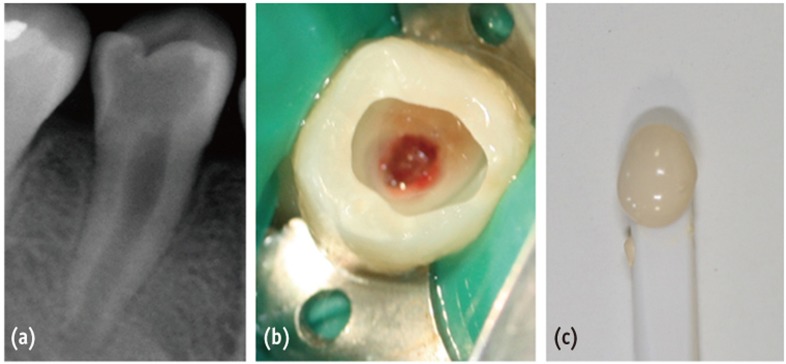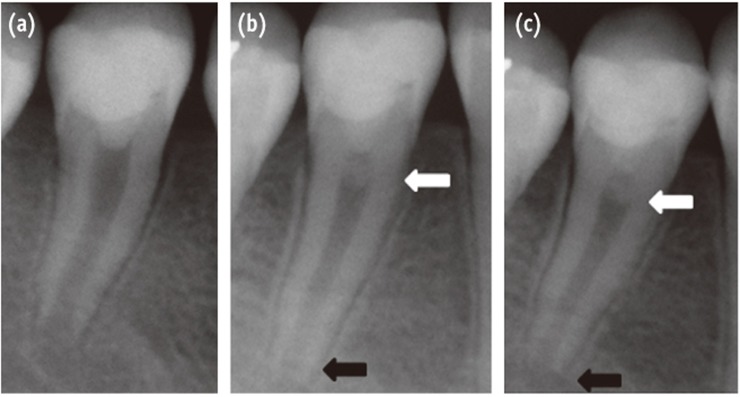Restor Dent Endod.
2013 Nov;38(4):258-262.
Conservative approach of a symptomatic carious immature permanent tooth using a tricalcium silicate cement (Biodentine): a case report
- Affiliations
-
- 1Laboratoire des Multimateriaux et Interfaces, UMR CNRS 5615, Department of Conservative Dentistry and Endodontics, Faculte d'Odontologie, Universite de Lyon, Hospices Civils de Lyon, Lyon, France. cyril.villat@univlyon1.fr
- 2Laboratoire des Multimateriaux et Interfaces, UMR CNRS 5615, Department of Biomaterials, Faculte d'Odontologie, Universite de Lyon, Hospices Civils de Lyon, Lyon, France.
- 3Department of Conservative Dentistry and Endodontics, Faculte d'Odontologie, Universite de Lyon, Hospices Civils de Lyon, France.
Abstract
- The restorative management of deep carious lesions and the preservation of pulp vitality of immature teeth present real challenges for dental practitioners. New tricalcium silicate cements are of interest in the treatment of such cases. This case describes the immediate management and the follow-up of an extensive carious lesion on an immature second right mandibular premolar. Following anesthesia and rubber dam isolation, the carious lesion was removed and a partial pulpotomy was performed. After obtaining hemostasis, the exposed pulp was covered with a tricalcium silicate cement (Biodentine, Septodont) and a glass ionomer cement (Fuji IX extra, GC Corp.) restoration was placed over the tricalcium silicate cement. A review appointment was arranged after seven days, where the tooth was asymptomatic with the patient reporting no pain during the intervening period. At both 3 and 6 mon follow up, it was noted that the tooth was vital, with normal responses to thermal tests. Radiographic examination of the tooth indicated dentin-bridge formation in the pulp chamber and the continuous root formation. This case report demonstrates a fast tissue response both at the pulpal and root dentin level. The use of tricalcium silicate cement should be considered as a conservative intervention in the treatment of symptomatic immature teeth.
MeSH Terms
Figure
Reference
-
1. Witherspoon DE, Small JC, Harris GZ. Mineral trioxide aggregate pulpotomies: a case series outcomes assessment. J Am Dent Assoc. 2006; 137:610–618. PMID: 16739540.2. European Society of Endodontology. Quality guidelines for endodontic treatments: consensus report of the European Society of Endodontology. Int Endod J. 2006; 39:921–930. PMID: 17180780.3. Mohammadi Z, Dummer PM. Properties and applications of calcium hydroxide in endodontics and dental traumatology. Int Endod J. 2011; 44:697–730. PMID: 21535021.
Article4. Nair PN, Duncan HF, Pitt Ford TR, Luder HU. Histological, ultrastructural and quantitative investigations on the response of healthy human pulps to experimental capping with mineral trioxide aggregate: a randomized controlled trial. Int Endod J. 2008; 41:128–150. PMID: 17956562.
Article5. Camilleri J, Pitt Ford TR. Mineral trioxide aggregate: a review of the constituents and biological properties of the material. Int Endod J. 2006; 39:747–754. PMID: 16948659.
Article6. Yun YR, Yang IS, Hwang YC, Hwang IN, Choi HR, Yoon SJ, Kim SH, Oh WM. Pulp response of mineral trioxide aggregate, calcium sulfate or calcium hydrate. J Korean Acad Conserv Dent. 2007; 32:95–101.7. Chang SW, Yoo HM, Park DS, Oh TS, Bae KS. Ingredients and cytotoxicity of MTA and 3 kinds of Protland cements. J Korean Acad Conserv Dent. 2008; 33:369–376.8. Roberts HW, Toth JM, Berzins DW, Charlton DG. Mineral trioxide aggregate material use in endodontic treatment: a review of the literature. Dent Mater. 2008; 24:149–164. PMID: 17586038.
Article9. Torabinejad M, Parirokh M. Mineral trioxide aggregate: a comprehensive literature review-part II: leakage and biocompatibility investigations. J Endod. 2010; 36:190–202. PMID: 20113774.
Article10. Chang SW. Chemical characteristics of mineral trioxide aggregate and its hydration reaction. Restor Dent Endod. 2012; 37:188–193. PMID: 23429542.
Article11. Parirokh M, Torabinejad M. Mineral trioxide aggregate: a comprehensive literature review-part III: clinical applications, drawbacks and mechanism of action. J Endod. 2010; 36:400–413. PMID: 20171353.
Article12. Parirokh M, Torabinejad M. Mineral trioxide aggregate: a comprehensive literature review-part I: chemical, physical, and antibacterial properties. J Endod. 2010; 36:16–27. PMID: 20003930.
Article13. Koubi G, Colon P, Franquin JC, Hartmann A, Richard G, Faure MO, Lambert G. Clinical evaluation of the performance and safety of a new dentine substitute, Biodentine, in the restoration of posterior teeth-a prospective study. Clin Oral Investig. 2013; 17:243–249.14. Darvell BW, WU RC. 'MTA'-an hydraulic silicate cement: review update and setting reaction. Dent Mater. 2011; 27:407–422. PMID: 21353694.
Article15. Laurent P, Camps J, About I. Biodentine induces TGF-β 1 release from human pulp cells and early dental pulp mineralization. Int Endod J. 2012; 45:439–448. PMID: 22188368.16. Han L, Okiji T. Uptake of calcium and silicon released from calcium silicate-based endodontic materials into root canal dentine. Int Endod J. 2011; 44:1081–1087. PMID: 21777256.
Article17. Villat C, Tran XV, Pradelle-Plasse N, Ponthiaux P, Wenger F, Grosgogeat B, Colon P. Impedance methodology. A new way to characterize the setting reaction of dental cements. Dent Mater. 2010; 26:1127–1132. PMID: 20728209.
Article18. Atmeh AR, Chong EZ, Richard G, Festy F, Watson TF. Dentin-cement interfacial interaction: calcium silicates and polyalkenoates. J Dent Res. 2012; 91:454–459. PMID: 22436906.19. Eghbal MJ, Asgary S, Baglue RA, Parirokh M, Ghoddusi J. MTA pulpotomy of human permanent molars with irreversible pulpitis. Aust Endod J. 2009; 35:4–8. PMID: 19335509.
Article20. Camilleri J. Characterization and hydration kinetics of tricalcium silicate cement use as a dental biomaterial. Dent Mater. 2011; 27:836–844. PMID: 21600643.21. Accorinte Mde L, Holland R, Reis A, Bortoluzzi MC, Murata SS, Dezan E Jr, Souza V, Alessandro LD. Evaluation of mineral trioxide aggregate and calcium hydroxide cement as pulp-capping agents in human teeth. J Endod. 2008; 34:1–6. PMID: 18155482.22. Leye Benoist F, Gaye Ndiaye F, Kane AW, Benoist HM, Farge P. Evaluation of mineral trioxide aggregate (MTA) versus calcium hydroxide cement (Dycal) in the formation of a dentine bridge: a randomized controlled trial. Int Dent J. 2012; 62:33–39. PMID: 22251035.23. Huang GT. Apexification: the beginning of its end. Int Endod J. 2009; 42:855–866. PMID: 19549154.
Article24. Aeinehchi M, Eslami B, Ghanbariha M, Saffar AS. Mineral trioxide aggregate (MTA) and calcium hydroxide as pulp-capping agents in human teeth: a preliminary report. Int Endod J. 2003; 36:225–231. PMID: 12657149.25. Iwamoto CE, Adachi E, Pameijer CH, Barnes D, Romberg EE, Jefferies S. Clinical and histological evaluation of white ProRoot MTA in direct pulp capping. Am J Dent. 2006; 19:85–90. PMID: 16764130.26. Witherspoon DE. Vital pulp therapy with new materials: new directions and treatment perspectives-permanent teeth. Pediatr Dent. 2008; 30:220–224. PMID: 18615987.
Article27. Accorinte ML, Loguercio AD, Reis A, Bauer JR, Grande RH, Murata SS, Souza V, Holland R. Evaluation of two mineral trioxide aggregate compounds as pulp-capping agents in human teeth. Int Endod J. 2009; 42:122–128. PMID: 19134040.
Article28. Bakland LK, Andreasen JO. Will mineral trioxide aggregate replace calcium hydroxide in treating pulpal and periodontal healing complications subsequent to dental trauma? A review. Dent Traumatol. 2012; 28:25–32. PMID: 21895969.
Article29. Asgary S, Eghbal MJ, Ghoddusi J, Yazdani S. One-year of vital pulp therapy in permanent molars with irreversible pulpitis: an ongoing multicenter, randomized, noinferiority clinical trial. Clin Oral Investig. 2013; 17:431–439.30. El-Meligy OA, Avery DR. Comparison of mineral trioxide aggregate and calcium hydroxide as pulpotomy agents in young permanent teeth (apexogenesis). Pediatr Dent. 2006; 28:399–404. PMID: 17036703.
- Full Text Links
- Actions
-
Cited
- CITED
-
- Close
- Share
- Similar articles
-
- Outcome of Regenerative Endodontic Treatment for an Avulsed Immature Permanent Tooth: A Case Report
- Interface between calcium silicate cement and adhesive systems according to adhesive families and cement maturation
- Microleakage and Shear Bond Strength of Biodentine at Different Setting Time
- An in Vitro Study of the Effects of Different Dentin Bonding Agents on the Prevention of Tooth Discoloration and the Sealing Ability of Calcium Silicate-Based Cement in Regenerative Endodontic Procedures
- The use of platelet rich plasma in the treatment of immature tooth with periapical lesion: a case report



